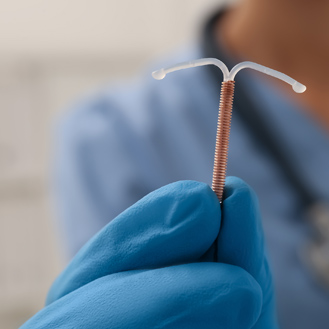
February 20, 2024
By WHEP Scholar, Drexel University College of Medicine
Intrauterine devices (IUDs) are an increasingly popular choice for contraception. There are two types: hormonal (which contain progestin, a form of progesterone) and non-hormonal, made with copper. You can discuss with your health care provider which one is best for you.
IUD Preparation - Choose the Type
You can discuss with your doctor which type of IUD best suits your needs and is safest for you to use. This will then most likely go through your insurance and be ordered, requiring a second visit for insertion.
- Hormonal IUD:
- Efficacy: 99.8%
- Can be used up to 8 years
- Can reduce menstrual bleeding and cramps
- Can cause irregular spotting, breast tenderness, acne and/or headaches
- Copper IUD:
- Efficacy: 99.2%
- Can be used up to 10 years
- Can cause more menstrual pain and heavier bleeding
IUD Pain Management
Multiple studies have shown that many of the interventions to help decrease the pain of IUD insertion are not very effective. Talk to your doctor about what they recommend and why. Some possible options include:
- Topical anesthetic: Your doctor may place a numbing cream on your cervix to help with the discomfort of the clamping of the cervix.
- Injected numbing agent: Similar to a topical anesthetic, your doctor could inject numbing agents around the cervix.
- Misoprostol: This is used to help soften the cervix and reduce the discomfort of insertion. This can be taken orally or placed in the vagina at home the day of insertion.
- Pain relievers: You can take 800 mg of ibuprofen before insertion. This may help with the cramping afterwards.
IUD Insertion Process
- Cervical examination: Your doctor will do a pelvic exam to examine your cervix and uterus.
- Sterile technique: To reduce risk of infection, your doctor will use long, Q-tip-like swabs with liquid on them to clean the vagina and cervix. They will also be wearing sterile gloves, and all of the equipment will have been sterilized.
- Clamping: Your doctor will use a device called a tenaculum to hold the cervix in place for the procedure and reduce the risk of problems with insertion.
- Sounding: Your doctor will use a thin, flexible tube to measure the depth of your uterus. This helps ensure accurate placement of the IUD.
- Insertion: The IUD is inserted in a similar manner to the sound into the uterus and placed so the strings can be felt coming out of the cervix.
IUD Post-Insertion Management
- Cramping and discomfort: This is common for a few days after insertion. Both ibuprofen and heat therapy (like a heating pad) work well to reduce cramping and pain.
- Bleeding: Immediately after, you may have light bleeding from the procedure. You can use a sanitary pad until this bleeding stops. Irregular spotting can be common for the first several months.
- Follow-up: About a month after insertion, there will be an appointment to check that your IUD is in place with a quick pelvic examination and/or ultrasound exam.
IUD Long-term Management
- Your IUD is effective from the day it is inserted, although it is generally recommended to wait to engage in sexual intercourse for 24 hours to minimize pain and bleeding.
- You should check the strings every month to make sure the IUD is still in place. If you cannot feel them, go to your doctor.
- Warning signs: Report severe pain, heavy bleeding, or signs of infection to your doctor. If you believe you may be pregnant, immediately go to your doctor as chances of ectopic pregnancies are increased with IUDs.
Sources/Resources: